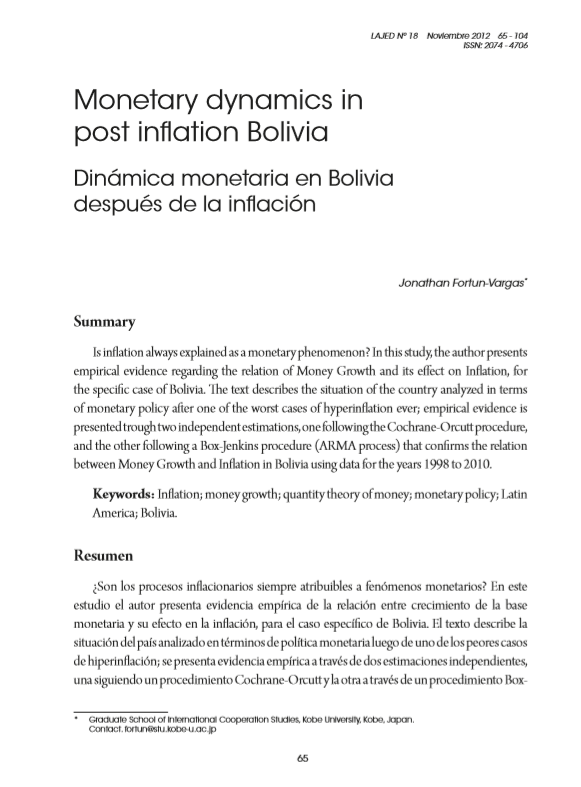Monetary dynamics in post inflation Bolivia
DOI:
https://doi.org/10.35319/lajed.201218131Keywords:
Inflation, money growth, quantity theory of money, monetary policy, Latin America, BoliviaAbstract
Is inflation always explained as a monetary phenomenon? In this study, the author presents empirical evidence regarding the relation of Money Growth and its effect on Inflation, for the specific case of Bolivia. The text describes the situation of the country analyzed in terms of monetary policy after one of the worst cases of hyperinflation ever; empirical evidence is presented trough two independent estimations, one following the Cochrane-Orcutt procedure, and the other following a Box-Jenkins procedure (ARMA process) that confirms the relation between Money Growth and Inflation in Bolivia using data for the years 1998 to 2010.
Downloads
References
Ball, L. & Sheridan, N. (2003). Does Inflation Targeting Matter? NBER Working Paper No.9577.
Barro, R. J. (2008). Macroeconomics: A Modern Approach: South-Western Pub.
Berg, A.; Borensztein, E. & Mauro, P. (2002). An evaluation of monetary regime options for Latin America* 1. The North American Journal of Economics and Finance, 13(3), 213-235.
Bokhari, S. M. H. & Ferdun, M. (2006). Forecasting Inflation through Econometric Models: An Empirical Study on Pakistani Data. Do u Üniversitesi Dergisi, 7(1), 39–47.
Brockwell, P. J. & Davis, R. A. (2009). Time series: theory and methods. Berlin, Germany: Springer Verlag.
Cagan, P. (1956). The monetary dynamics of hyperinflation. Studies in the quantity theory of money(pp. 25-117). Chicago, USA: University of Chicago Press.
Capistrán, C., & Ramos-Francia, M. (2009). Inflation Dynamics in Latin America. Contemporary Economic Policy, 27(3), 349-362
Cariaga, J. L. (1996). Estabilización y desarrollo: importantes lecciones del programa económico de Bolivia. La Paz, Bolivia: Editorial los Amigos del Libro.
Crowder, W. J. (1998). The Long Run link between Money Growth and Inflation. Economic Inquiry, 36(2), 229-243.
De Mello, L. & Moccero, D. (2009). Monetary Policy and Inflation Expectations in Latin America: Long-Run Effects and Volatility Spillovers. Journal of Money, Credit and Banking, 41(8), 1671-1690.
Dewald, W. G. (1998). Money still matters, review. Federal Reserve Bank of St. Louis, 80, 13–24.
Durbin, J. & Watson, G. S. (1950). Testing for serial correlation in least squares regression: I. Biometrika, 37, 409-428.
Dwyer, G. & Hafer, R. (1999). Are money growth and inflation still related? Economic Review (Q2), 32-43.
Dwyer Jr, G. P. & Hafer, R. W. (1988). Is money irrelevant? Federal Reserve Bank of St. Louis Review, 70(3), 3-17.
Friedman, M. (1994). Money mischief: Episodes in monetary history. Mariner Books.
Granger, C. W. J. & Newbold, P. (1974). Spurious regressions in econometrics. Journal of Econometrics, 2, 111-120.
Grauwe, P. D. & Polan, M. (2001). Is Inflation Always and Everywhere a Monetary Phenomenon? International Economics Working Papers Series.
Hallman, J. J.; Porter, R. D. & Small, D. H. (1991). Is the price level tied to the M2 monetary aggregate in the long run? The American Economic Review, 841-858.
Hamilton, J. D. (1994). Time series analysis. Boston, MA, USA: Princeton University Press.
Harberger, A. C. (1978). A primer on inflation. Journal of Money, Credit and Banking, 10(4), 505-521.
Hofstetter, M. (2009). Inflation Targeting in Latin America: Toward a Monetary Union? Documentos CEDE.
Hume, D. (1752). Of money. Essays, London: George Routledge and Sons.
Mankiw, N. G. (2010). Macroeconomics. Boston, MA, USA: W H Freeman & Co.
McCandless, G. T. & Weber, W. E. (1995). Some monetary facts. Federal Reserve Bank of Minneapolis Quarterly Review, 19(3), 2-11.
Mullineaux, D. J. (1980). Inflation expectations and money growth in the United States. The American Economic Review, 70(1), 149-161.
Nelson, E. (2003). The future of monetary aggregates in monetary policy analysis* 1. Journal of Monetary Economics, 50(5), 1029-1059.
Pankrátz, A. (1983). Forecasting with univariate Box-Jenkins models: concepts and cases. Chicago, USA: Wiley & Sons.
Pindyck, R. S. & Rubinfeld, D. L. (1998). Econometric models and economic forecasts. Boston, MA, USA: Irwin/McGraw-Hill.
Sachs, J. D. (1986). The Bolivian hyperinflation and stabilization. National Bureau of Economic Research Cambridge, Mass., USA. AEA Papers and Proceedings, 77(2) May 1987
Svensson, L. E. O. (1999). Inflation Targeting: Some Extensions. Scandinavian Journal of Economics, 101(3), 337-361.






